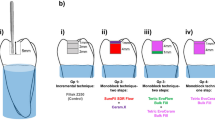Abstract
Objectives
The aim of this study was to analyze the porosity of three photopolymerizable resin composites: one high-viscous resin composite (Filtek™ P60®, 3 M™ ESPE™), one moderate-viscosity resin composite (Grandio®, VOCO™), and one low-viscous resin composite (Filtek™ Supreme XTE®, 3 M™ ESPE™).
Materials and methods
A total of 36 cylindrical samples with a height of 2 mm and a diameter of 2 mm were prepared using PTFE molds. Eighteen cylinders were prepared by two incremental applications of 1 mm into the molds, then polymerized (group 1). For the other 18 samples (group 2), the first increment was polymerized before the second addition was made. The average porosity percentage and the average porosity volume were evaluated by high-resolution tomography (Nanotom M® – Phoenix X-RayTM, Wunstorf, Germany). The impact of incremental applications in terms of porosity was also evaluated.
Results
Irrespective of the protocol used, the low viscous material presented an average porosity percentage and an average porosity volume significantly greater than those of the other materials. Incremental application (group 2 samples) led to an increase in the average porosity percentage and volume irrespective of the material compared to the group 1 samples.
Conclusions
High-resolution tomography appeared to be a particularly suitable tool for studying the porosity of resin composites. The viscosity and the handling of these materials seemed to be influential factors on their porosity.
Clinical relevance
The presence of porosities in dental resin composites remains an objective reality, especially with low-viscous resin composites. Since the intrinsic porosity of the materials can be neither controlled nor modified by the operator, rigorous and iterative clinical protocols still remain the best way to limit inclusion of porosities in the resin composites.



Similar content being viewed by others
References
Stansbury JW (2000) Curing dental resins and composites by photopolymerization. J Esthet Dent 12(6):300–308
Watts DC (2005) Reaction kinetics and mechanics in photopolymerised networks. Dent Mater 21(1):27–35
De Gee AJ (1979) Some aspects of vacuum mixing of composite resins and its effect on porosity. Quintessence Int Dent Dig 10(7):69–74
Jorgensen KD (1980) Restorative resins: abrasion vs. mechanical properties. Scand J Dent Res 88(6):557–568
Murray PE, Garcia Godoy C, Garcia Godoy F (2007) How is the biocompatibility of dental biomaterials evaluated? Med Oral Pathol Oral Chir Buccal 12(3):E258–E266
Oysaed H, Ruyter IE (1987) Water sorption and filler characteristics of composites for use in posterior teeth. J Dent Res 65(11):1315–1318
Bellenger V, Verdu J, Morel E (1989) Structure-properties relationship for densely cross-linked epoxy-amine systems based on epoxide or amine mixtures. J Mater Sci 24:63–68
Eliasson ST, Romano AD, Geistfeld RE, Hill GL (1976) Surface problems with composite resin restorations. Northwest Dent 55(2):70–74
Fishel HF, Cruickshanks-Boyd DW, Davies EH (1982) Setting characteristics and porosity of a composite resin. Quintessence Int Dent Dig 13(12):1345–1351
Fortunate J, Santos F, Leinfelder KF (1983) Microporosity in composite resin. J Dent Res 62:671, Abstr No. 191
Skjörland KK, Hensten-Pettersen A, Orstavik D, SÖderholm KJ (1982) Tooth colored dental restorative materials: Porosities and surface topography in relation to bacterial adhesion. Acta Odontol Scand 40(2):113–120
Fano V, Ortalli I, Pozela K (1995) Porosity in composite resins. Biomaterials 16(17):1291–1295
Gjerdet NR, Hegdahl T (1978) Porosity of resin filling materials. Acta Odontol Scand 36(5):303–307
Asmussen E (1977) Penetration of restorative resins into acid etched enamel. II. Dissolution of entrapped air in restorative resin monomers. Acta Odontol Scand 35(4):183–191
Asmussen E (1981) Plastfyldningsmaterialer. Odontologisk Boghandel Forlag, Copenhagen, pp 134–137
Fischel HF, Tay WM (1977) Effect of manipulative techniques on porosity in composite resin restorations. J Dent Res 56:Al51, Abstr. No. 432
Gotfredsen P, Hörsted P, Kragstrup J (1983) Porosity of restorative resins. Scand J Dent Res 91(4):312–315
Van Dijken JW, Ruyter IE, Holland RI (1986) Porosity in posterior composite resins. Scand J Dent Res 94(5):471–478
Jörgensen KD, Hisamitsu H (1983) Porosity in microfill restorative composites cured by visible light. Scand J Dent Res 91(5):396–405
Ogden AR (1985) Porosity in composite resins–an Achilles’ heel? J Dent 13(4):331–340
Rey L, Duchet J, Galy J, Sautereau H, Vouagner D, Carrion L (2002) Structural heterogeneities and mechanical properties of vinyl/dimethacrylate networks synthesized by thermal free radical polymerization. Polymer 43:4375–4384
Boskocevic D, Duray SJ, Suh BI (1991) Pressure effects on porosity of dental composites during curing. Bisco, Inc, Schaumburg, IL, USA
Conflict of interest
The authors have no financial affiliation or involvement with any commercial association with direct financial interest in the materials discussed in the manuscript. Any other conflict of interest is disclosed.
Author information
Authors and Affiliations
Corresponding author
Rights and permissions
About this article
Cite this article
Balthazard, R., Jager, S., Dahoun, A. et al. High-resolution tomography study of the porosity of three restorative resin composites. Clin Oral Invest 18, 1613–1618 (2014). https://doi.org/10.1007/s00784-013-1139-4
Received:
Accepted:
Published:
Issue Date:
DOI: https://doi.org/10.1007/s00784-013-1139-4




